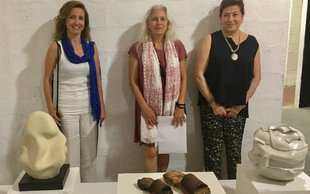
Taking Lebanese Ceramic Art to a Higher Place
Ceramics is getting more and more popular and this competition proved us...
The fields marked with * are mandatory
Lebanese street art prodigy on capturing the imagination of a younger Lebanese generation and gaining the world's attention while he was at it
What a princess’ kiss does for a frog, Yazan Halwani does to the walls of Beirut, morphing bland walls into murals that inspire thought and awe. This 20-something-year-old street art prodigy wishes to capture the imagination of a younger Lebanese generation that is grappling for cultural roots.
“We are a country that cannot identify a core cultural identity,” says Halwani. “What I try to express at the current time is kind of a cultural Arab identity because we don’t have much of that.”
People transcribe memories in a diary; Halwani does the same thing but on the scale of a city. He takes it upon himself to morph the walls of cities into the pages of their own diary book.
“[Lebanese] tend to have a patchwork of cultural elements or symbols that are not representative of the Lebanese population. I like the fact that by painting these images on the walls it might make people think that there is kind of a unified cultural element.”
A desire to evoke nostalgia as well as establish a common cultural handshake drives Halwani to drape cities with his gems. His most recent mural, a larger-than-life-sized portrait of legendary singer Sabah, adorns the side of a building on Hamra street.
“The Sabah mural is about bringing back what people living around this wall before present times used to call the Golden Era of Hamra which is pre-war Hamra.”
Fayrouz is another legend that he immortalized with his spray cans on Gemmayze. Not shying away from lesser known faces, Halwani’s portrait of the late Ali Abdallah pays tribute to the late homeless man who lived and died on the streets of Hamra.
From household names to those without a house, “they are all parts of the stories of the city” and therefore deserve our undivided attention.
Could Halwani be the most likable graffiti artist? Instead of running from the authorities, he convinces one officer to set his gun aside to paint with him.
He tells of a brief collaboration between him and a Lebanese officer with an M16 gun on his back who is painting in pink, an unlikely scenario that forces us to reconsider lazy assumptions and deep-seated stereotypes.
“I really don’t care anymore about the idea that a legitimate graffiti artist needs to be doing things illegally - in fact, I am doing the complete opposite of that by actually doing big projects that are for the community.”
His work has caught the attention of the international art scene, appearing beside art megastar Damien Hirst in a private collection and next to graffiti-giant Sheppard Fairey at the UNESCO graffiti biennale in Berlin. Halwani has been commissioned for his talent in Singapore, Dubai, Paris and Tunisia.
“When I went to Tunisia, I painted Mahmoud Darwish, a very interesting Arab cultural figure related to the Israeli-Arab conflict who has a kind of peaceful approach to this conflict,” says Halwani. “I wanted to leave them with a small reminder of him so I painted Mahmoud Darwish alongside the quote ‘Kayfa Nachfa Min 7obb Tunis’ [or 'How Will We Heal From Tunis' Love]."
At this stage, the local street art scene has immense growing potential.
“I think street art is still really new in Beirut. It hasn’t been a decade since the first artistic mural was painted. And I think the scale of street art is getting bigger and bigger at the moment. The Sabah mural was the first building painted by a Lebanese artist [...] I think this project showed that you can paint large-scale murals easily with some dedication and I hope it will inspire others.”
Moving on: What does Halwani do when he’s not busy making magic? When he’s not conjuring up magic onto the walls of blissfully chaotic Beirut, the boy’s surely gotta eat.
Barbar: “I like it cause it’s close to my studio and it’s convenient. My favorite thing to order is the shrimp and chicken sandwich.”
Roadster: “I enjoy the occasional bite there”
Radio Beirut: “It has a bit of added value. It’s a bit of a special place, not like other pubs.”
De Prague: “A nice place... It’s big, calm, not very loud.”
Art
Arts
Articles
Interviews
Occupation
Artist
Get updates on what's happening in Beirut, customise and review the content you want.
Sign up now! It's free!